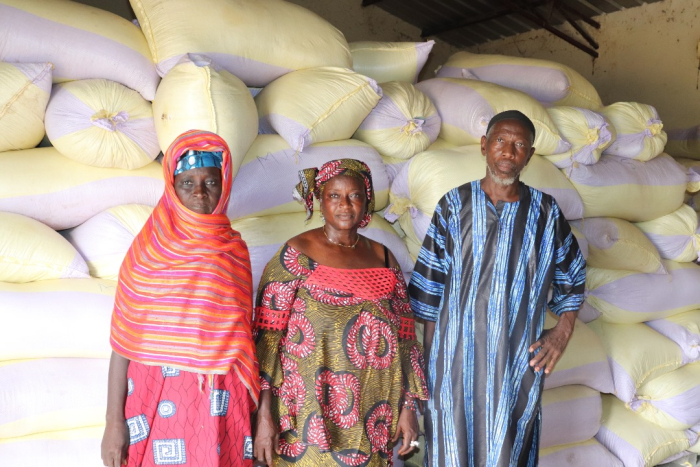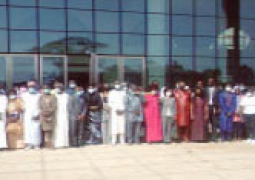
Speaking on the unprecedented results of the initiative, Sama revealed that many rice fields once virtually abandoned, have now been reclaimed and cultivated, thanks to the timely intervention of the project. The revitalisation has led to increased production, bumper harvests, and a noticeable rise in farmers’ savings.
He described the project as a lifeline for local farmers, citing its transformative impact on rice production and post-harvest operations. “This rice field is our livelihood,” Sama said. “ROOTS stepped in when we were facing serious challenges ranging from shortages of seeds, fertilisers, ploughing services, herbicides, and broken canal gates.”
“ROOTS isn’t just giving handouts,” Sama explained. “They are helping us sustain ourselves. That’s why we charge for the harvester and tractor services to ensure the equipment are maintained and continue to benefit the community,” he said during an interview with journalists, who visited ROOTS project sites in the region.
Through the ROOTS 4P Matching Grant, officials said, the Rice Farmers Association in the area received a combine harvester making post-harvest operations easier and significantly reducing losses. Also, under the Subsidized Input Support Program, they received 4 tractors, now being used sustainably by offering paid services to members.
Nuha Nyangado, capacity development, knowledge management, and communication officer for the ROOTS Project, emphasised the transformative impact of the project on local rice farmers during a recent media tour of Jahally and Pacharr, widely regarded as the rice basket of the country.
Through its crisis response initiative, he said, the ROOTS Project has invested significantly in agricultural infrastructure and input support. Key achievements include: Replacement of 104 irrigation gates, Rehabilitation of 11 culverts, and also the provision of a subsidised input package which include: fertilisers, certified seeds, ploughing services, and herbicides
“These interventions have had a profound impact,” Nyangado noted. “Some farmers have reported a 50% increase in savings, while others have seen dramatic boosts in production. For instance, a farmer with just 0.5 hectares of rice land harvested over 50 bags of paddy rice, an unprecedented yield.”
He attributed much of this success to the improved water management enabled by the new gates, which allow farmers to control irrigation more effectively. The input package has also addressed long-standing challenges by delivering essential supplies directly to farmers’ doorsteps.
“It’s crucial that the public, our donors, and the government are aware of the progress we’re making. Seeing the results firsthand and hearing testimonies from farmers is incredibly rewarding,” he said.
Nyangado expressed his admiration for the resilience and determination of the farmers, many of whom have reclaimed previously abandoned fields thanks to ROOTS support, saying: “Some of these rice fields had been left idle for years due to flooding or lack of access. Today, they are thriving. That speaks volumes about the impact of our work,” he added.
The ROOTS Project is aligned with the Ministry of Agriculture’s broader goal of achieving national rice self-sufficiency by 2030. According to Nyangado, the project is well on track to contribute meaningfully to that vision.
“We want people to understand that agriculture is not just for the older generation. As Maruo highlighted, there are currently 40 young people actively working in the rice fields, and these young people are all supported by the project. This is the message we aim to instill in the youth – that agriculture is a form of entrepreneurship.”
“Our goal is to encourage young people to become employers rather than job seekers, empowering them to create opportunities for others.”
Musa Darboe of Maruo Farm, widely recognised as one of the region’s most successful rice farmers, highlighted the significant impact the ROOTS Project has in the CRR, adding: “We are working closely with ROOTS to promote youth-led entrepreneurship in rice production. The project is providing start-up capital for young people, while Maruo Farm offers the platforms, services, and inputs they need to succeed. Beyond that, ROOTS has made substantial contributions in the area, enabling us to collaborate with more farmers,” he said.
Darboe noted that the repair of irrigation gates has brought tremendous benefits to local farmers. “Thanks to the gate repairs, farmers in the area have experienced bumper harvests. Many farmers had previously been unable to access their rice fields due to poor infrastructure.”
John Mendy, regional agricultural director, CRR South, also emphasised the achievements made in the area following the intervention of the ROOTS Project.
“Usually, there are rice fields in the region that lack water during the dry season. Only the inland areas typically retain water through tidal irrigation. However, when ROOTS came in and repaired the gates and culverts, many more areas gained access to water, which significantly boosted production,” he explained.
He noted that farmers in the perimeter are highly satisfied with the results. “In fact, they mentioned that they haven’t cultivated Jahally in this season for many years. Now, farmers are actively working across nearly all parts of the rice fields, which has led to a bumper harvest,” he said.




